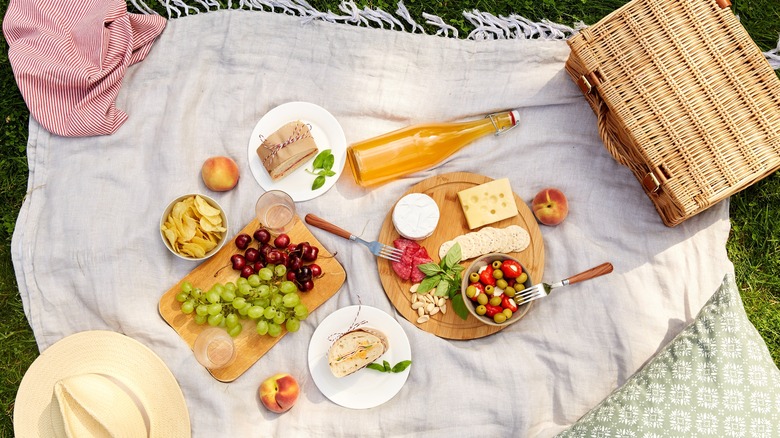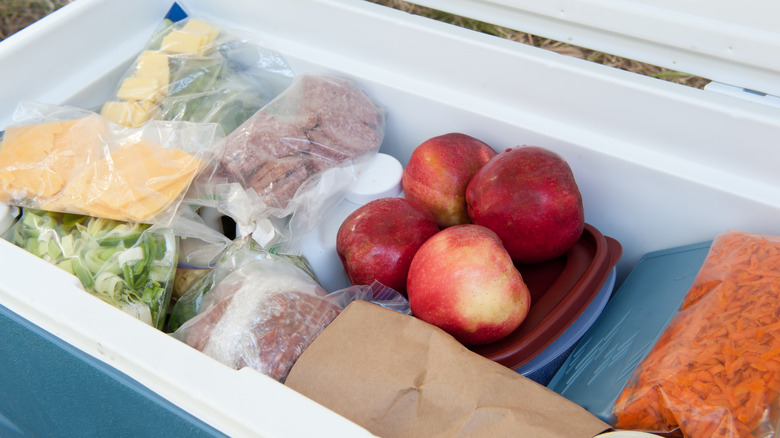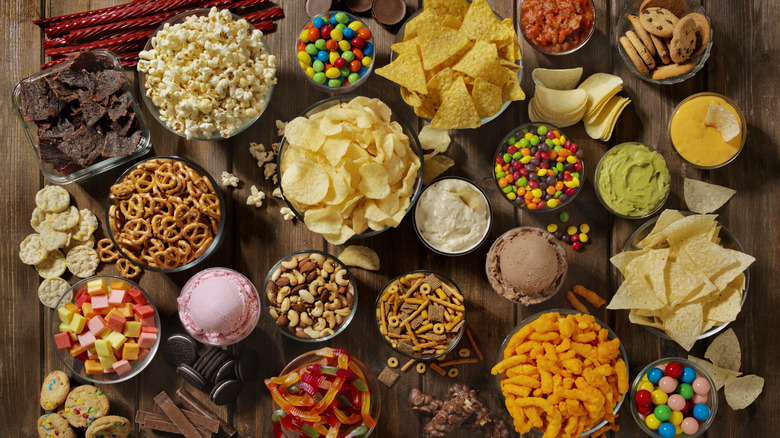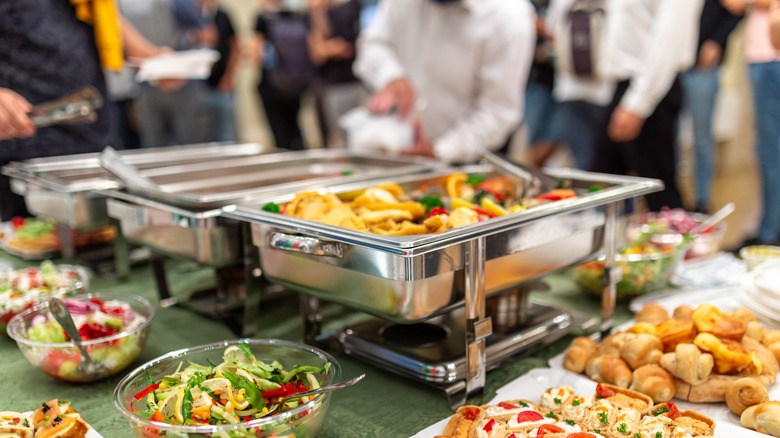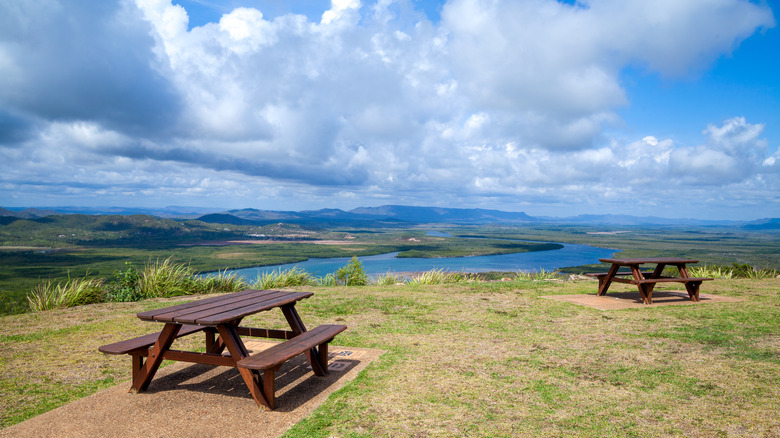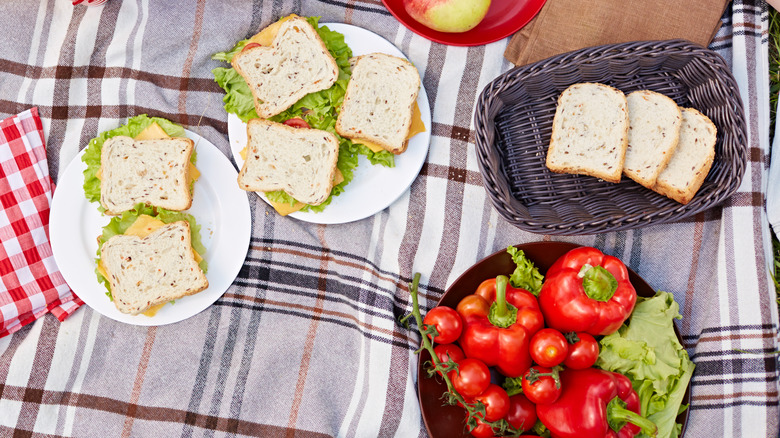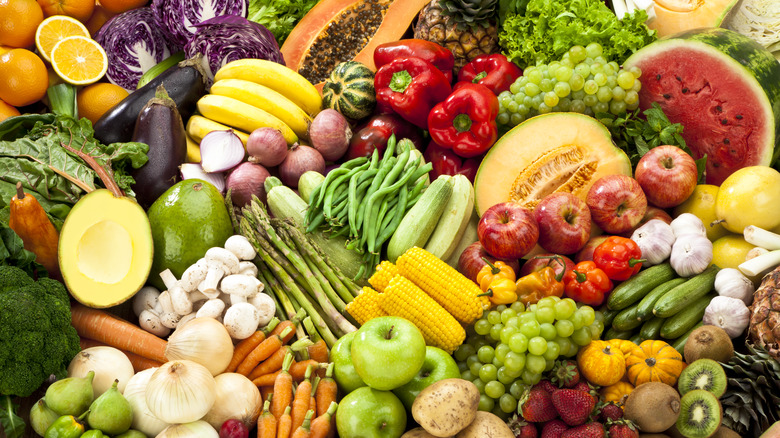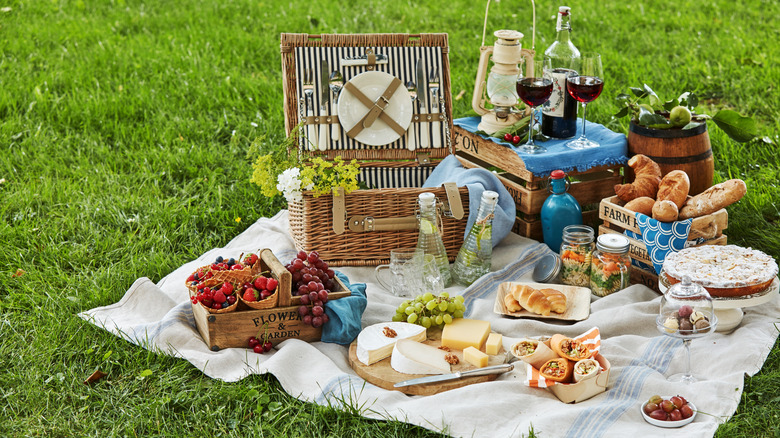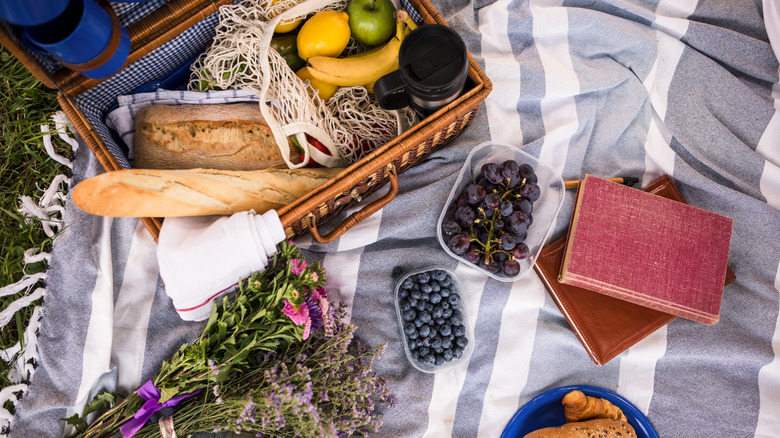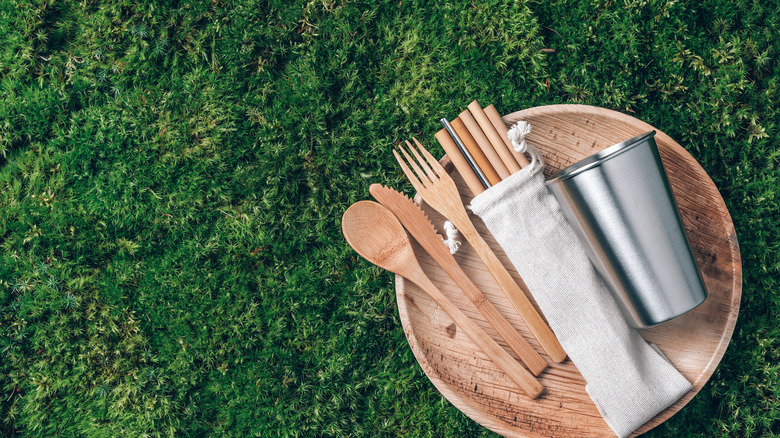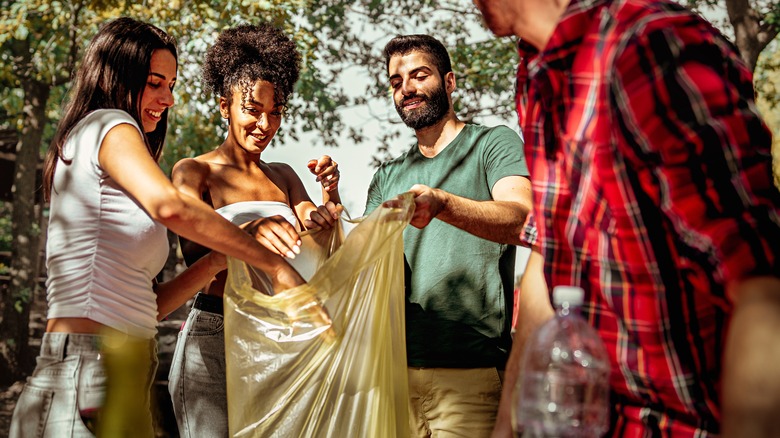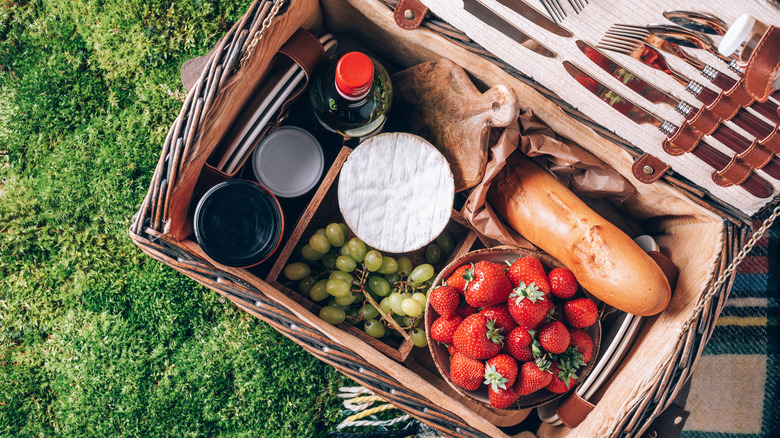14 Picnic Mistakes Everyone Makes
Are you excited about basking in the glorious sunshine, surrounded by the beauty of the natural world and indulging in tasty treats? Well, put the potato salad on ice, and leave that picnic blanket folded neatly in the closet for a moment because we need to talk. Picnics may seem like a breeze, but there are some common mistakes that almost everyone makes when planning the perfect outdoor feast.
Mistakes range from the low-key — making sandwiches that go soggy or not decorating nicely — to the much more serious — like leaving food out for too long. Some mistakes might lead to slight disappointment while others can cause food poisoning, so you should spend time making sure your picnic is safe and enjoyable for everyone invited.
In this article, we're going to spill the beans on these picnic blunders so that you can avoid them like a pro. So, grab a cold lemonade, kick back, and let's take a look at the 14 picnic mistakes that everyone makes. It's time to improve your picnic skills, and make every outing a truly memorable experience!
Leaving food out too long in warm weather
Maybe you want to throw a picnic that your guests will never forget — but not because they went home in gastrointestinal distress. When you leave certain foods out of the fridge for too long, bacteria grow, which can lead to food poisoning. We're sure that you don't want to give your nearest and dearest stomach bugs, so make sure you don't leave food outside for too long — especially in warm weather.
According to the USDA, any food that requires refrigeration shouldn't be left at room temperature for more than 2 hours. However, if the temperature is over 90 degrees, you shouldn't leave food out for more than 1 hour.
This doesn't mean that you can't pack foods that need refrigeration when picnicking, but you should use a cooler. A quality cooler filled with ice packs will keep food at 40 degrees or below. This is out of the "danger zone" at which bacteria grow fastest. If you're planning a leisurely picnic, not only should you use a cooler to get refrigerated foods to your picnic spot, but put them back in the cooler when you're not actively dishing them out.
So, make sure your picnic is memorable because of the food quality or the gorgeous location you picked, rather than because everyone went home and got sick for 24 hours straight.
Not using ice packs in your cooler
You're all set for your epic summer picnic adventure. You've got the most mouthwatering spread of sandwiches, salads, and refreshing beverages, and you've even packed a sweet treat or two for dessert. Now, here's the big question: What's the best way to keep all that deliciousness cool and fresh?
Some of you might be thinking, "Hey, why not just toss a bunch of ice into the cooler and call it a day?" Well, don't act right away because using loose ice instead of ice packs is a picnic mistake that you want to avoid.
As the ice inevitably melts during the day, you're left with a cooler full of water. Not only is this messy, but if you don't package all your food securely enough, water can get inside and ruin it. Those tasty sandwiches you packed in cellophane? Now they're a soggy mess, and you're left hungry and disappointed.
Ice packs may seem like a minor detail, but they can make a world of difference when it comes to preserving the quality and taste of your food. What's more, you can reuse them. Simply pop them back in the freezer after your picnic, and they'll be ready for next time.
Not packing enough shelf-stable food
It's easy to get carried away thinking about all the fussy foods that you want to pack for a picnic. Maybe you're excited about your famous rice noodle salad, or you've picked up a selection of gourmet cheeses. Or perhaps your friends and family get disappointed if you don't pack your signature guacamole. However, it's a mistake not to pack enough shelf-stable food.
But, what exactly do we mean by "shelf-stable" food? We're talking about those delightful treats that can withstand the test of time without refrigeration. This might be chips, crackers, trail mix, cookies, or candy bars.
These might not seem as exciting as homemade offerings, but they're a great way to bulk out a picnic, and they don't need refrigeration. This means there's no need to worry about whether you're keeping them at a safe temperature, and you can free up cooler space for chilled drinks or an impressive dessert.
Packing hot food
Packing hot food is a picnic blunder that can turn your outdoor feast into a lukewarm disappointment. We get it — the temptation to bring along piping hot dishes straight from the stove can be pretty enticing. Maybe your saag aloo is known throughout your neighborhood and beyond, or your pot pie is legendary, but packing hot food can be more trouble than it's worth.
One of the main considerations is food safety. Bacteria love to party in the "danger zone" — that's the temperature range between 40 degrees and 140 degrees. According to the USDA, when food stays within this temperature range for an extended period, those pesky bacteria multiply like crazy, potentially causing foodborne illnesses that can put a damper on your picnic fun.
So, if you intend to bring hot food, you'll need to find a way to keep it at temperatures above 140 degrees. For instance, by using chafing dishes. This adds an unnecessary extra step and a whole load of bulky equipment to your picnic experience.
Instead, opt for foods best served chilled or at room temperature. Think salads, sandwiches, wraps, fresh fruits, cheeses, and even cold pasta or noodle dishes. These options not only eliminate safety concerns, but also lend themselves well to outdoor dining.
Not paying attention to aesthetics
If you want to host a picnic that your friends and family members will be talking about for years, it's important to pay attention to aesthetics, not just the food. Sure, not every picnic has to be Instagram-worthy, but if it's a special occasion, it's nice to style your picnic.
A well-styled picnic takes your excursion to the next level. It sets the stage for a memorable gathering, and shows your companions that you've put thought and care into creating a beautiful ambiance. When you take the time to curate a visually pleasing picnic setup, you're creating a feast for the eyes that complements the delicious feast you're about to chow down on.
There are plenty of ways to make your picnic setup look as good as the food tastes. Using pillows and rugs to create an inviting and comfortable picnic spot instantly elevates the occasion. You can also consider choosing a theme for your picnic decor. Whether it's a bohemian garden party, a tropical paradise, or a classic vintage picnic, having a theme helps guide your decor choices, and creates a harmonious look.
What's more, try picking a color palette that suits the mood and setting of your picnic. Use soft pastels for a romantic vibe, vibrant hues for a festive feel, or earthy tones for a rustic touch. Incorporate these colors into your blankets, cushions, tablecloths, and even the food presentation.
Choosing the wrong location
Fellow picnic lovers take note — finding the perfect picnic spot is a big deal. You can make the most delicious picnic recipes and decorate beautifully, but if the location's all wrong, you won't have as much fun as you could have done. Some people might even have a bad time because of the location.
Picture this: a beautiful meadow full of wildflowers with a gentle breeze rustling through the trees, or a serene lakeside setting with stunning views. When you choose a spot that offers natural beauty and a tranquil atmosphere, you create a magical backdrop that enhances the overall ambiance of your picnic.
But it's not just about looks. The right picnic spot also provides practical benefits that can make your outing more comfortable and convenient. Consider factors such as accessibility, shade, and seating options. Is the spot easily reachable with all your picnic gear or for guests with mobility needs? Does it offer shelter from the sun? Are there picnic tables, benches, or grassy areas to sit on? These considerations can greatly impact your comfort and enjoyment during the picnic.
Also, think about the people joining you. If you're planning an all-ages family picnic, you'll want ample space for kids to run around, and you might want to avoid open water. While if you're planning a romantic picnic for you and your partner, you may prefer a more secluded spot.
Packing sandwiches that get soggy
Who doesn't love a creative, well-executed sandwich? One problem with packing sandwiches for a picnic is that those with wetter fillings quickly get soggy, leaving you with a subpar snack.
There are a number of ways you can keep sandwiches from getting soggy. First, opt for bread varieties that can withstand moisture without turning into a soggy sponge. Think crusty baguettes, ciabatta rolls, or hearty whole grain bread. Then, create a moisture barrier to protect your bread from the juicy fillings. Spread a thin layer of condiments on the inside of the bread slices. This layer acts as a shield, preventing the bread from getting soaked by the filling ingredients.
Finally, layer your ingredients wisely. Start with moisture-resistant condiments, followed by robust fillings like cheese or lettuce that can act as a barrier between the bread and more delicate ingredients. Place the juicier ingredients, such as tomatoes or pickles, in the center to minimize direct contact with the bread.
However, if you're still worried about wet 'wiches, pack the fillings separately from the bread. Bring small containers or Ziploc bags for your ingredients, and assemble the sandwiches on-site. This way, your bread remains fresh and dry until the very moment you're ready to devour your creation.
Not washing fruit and vegetables
Between organizing the details, inviting guests, and making delicious dishes, there's a lot of work involved with planning a picnic. So, we can understand why you might want to shorten your to-do list by not washing the apples and grapes you packed, or the carrots and cucumbers you chopped up as crudites. But, not washing fruits and vegetables can cause your fellow picnickers to leave with more than they bargained for.
No matter how fresh and lovely fruits and vegetables look, they can sometimes carry dirt, pesticides, bacteria, and other unwanted hitchhikers (via the CDC). Washing your produce helps remove these potential contaminants, making your fruits and veggies safer to eat, and reducing the risk of foodborne illnesses.
There's also the issue of wax and coatings. Some fruits, like apples and cucumbers, are often coated with a thin layer of wax to help preserve freshness and appearance. While these coatings are generally food-grade and safe to consume, they can accumulate dust, dirt, and other impurities over time. Giving your produce a good wash helps remove any residues or build-up on the surface, giving you a cleaner, more enjoyable bite.
Forgetting to cater for dietary requirements
Imagine unpacking a spread of sandwiches, crackers, pasta salad, and fudgy brownies for dessert, only to learn one of your guests follows a gluten-free diet and can't eat anything on the menu. Not only will that person leave hungry and disappointed, but you'll probably be kicking yourself for weeks to come.
With the rise of plant-based diets and more people suffering from food allergies, it's important to remember to cater to all your guests' dietary requirements. If you're planning a picnic for just a couple of close friends or family members, you probably already know if there's anything they don't or can't eat. However, when you organize a big event, it's worth asking all your guests whether they have any dietary requirements.
It's easy enough to make something to suit most diets. For instance, for vegans, you can swap out regular mayo for vegan mayo in dishes such as potato salad, and stay away from dairy-based salad dressings. While for those with gluten intolerances, you can use gluten-free pasta in the pasta salad and make rice- or grain-based dishes.
If you're worried about how to cater to a range of diets, you could always consider hosting a potluck picnic, with everyone bringing a dish or two. This way, everyone will have something they can eat.
Packing too much food
Packing too much food is one of the most common picnic mistakes. Of course, you want to make sure there's plenty of grub to go around, but stuffing your picnic basket to the brim with an abundance of food is a mistake you'll want to avoid.
Not only does it take a lot of time and effort to make food for a picnic, but you also have to get it to your picnic spot. Lugging around an overflowing picnic basket can quickly turn your leisurely outing into a strenuous workout. We all love a good feast, but carrying an excessively heavy load can take away from the fun of the experience. What's more, packing too much food can lead to unnecessary waste. Not only is it a bummer to see all that food go to waste, but it's also a hassle to pack up and carry the excess back home.
It's impossible to calculate exactly how much food you'll need for a picnic, but you can estimate how much food you'll need. If you're packing sandwiches, for instance, you might assume that everyone will want one sandwich each. However, if you're packing sandwiches and quiche or a hearty salad, people might only eat half a sandwich.
So, use your judgment, and try to pack enough so that nobody goes hungry but not so much that there'll be tons of leftovers.
Forgetting to bring utensils and other essentials
Yes, we know — there's a lot you need to bring on a picnic, and that makes it easy to leave some of the essentials behind. But, it's important not to forget items that you'll definitely need on your picnic or that will make your life easier. You don't want to be left trying to eat your salad with your hands or wiping your mouth on the corner of your picnic blanket because you forgot napkins.
Exactly what you need to pack depends on what you'll be serving. For instance, if you're packing a crusty loaf that you intend to cut al fresco, you'll need a bread knife, or if you want to bring wine, you shouldn't forget the corkscrew. However, it's safe to assume that most people will need plates, eating utensils, serving utensils, cups or glasses, and a supply of paper napkins.
If you're worried about forgetting anything, write yourself a picnic checklist,and cross items off once you've packed them.
Not bringing a trash bag
You've finished your picnic and it's time to clear up — but only then do you realize that you don't have anywhere to pack your rubbish into. No picnicker worth their salt would litter a natural area, so you're forced to pack your empty chip packets and half-eaten sandwiches back in your cooler or picnic basket with leftovers that you want to eat.
All of this could have been solved with a simple trash bag. By bringing a trash bag, you're showing respect for the environment, ensuring cleanliness, and making cleanup a breeze. It keeps your picnic area organized, making it easier to clean up and leave no trace behind.
It's also worth noting that a trash bag keeps critters and unwanted guests at bay. Leaving your picnic area strewn with leftover food scraps and trash while you're eating or relaxing after your meal is an open invitation for insects, birds, and other curious creatures to join the party.
Crushing delicate food
From soft fruits to sliced cake to sandwiches, some foods are more delicate and prone to getting crushed than others. So, it's important to think ahead and pack your cooler or picnic basket properly to avoid crushing delicate food.
The simple way to do this is to pack the heaviest items, such as cans of drink and ice packs, on the bottom of your basket or cooler and the most delicate items at the top. In the middle, you can pack foods like trail mix or granola bars that aren't especially heavy but aren't delicate enough to need to go right on the top layer.
Alternatively, opt for rigid, crushproof containers for your delicate foods. Hard-sided containers, such as Tupperware or plastic storage boxes, offer more protection than flimsy bags or less sturdy plastic takeout containers. Make sure the containers fit snugly in your basket, leaving minimal room for movement.
Forgetting the picnic blanket
You've found the perfect picnic spot, the sun is shining, and the aroma of delicious food fills the air. But wait a minute — where are you going to sit? That's where the trusty picnic blanket comes in.
It might seem like one extra thing to pack, but it's worth its weight in gold when it comes to comfort. Sure, you could plop down on the grass or the sand, but let's be honest, that might not be the most comfortable option. A picnic blanket offers a soft surface to recline on, allowing you to relax and enjoy your meal without the discomfort of lumpy ground or scratchy surfaces. Plus, with a picnic blanket, you create a hygienic barrier between your delectable spread and the ground beneath.
So, what if you don't own a picnic blanket? It doesn't have to be an official one to get the job done. You could also enjoy your picnic on a blanket or throw of any kind, an area rug, a large tablecloth, or a bed sheet.

